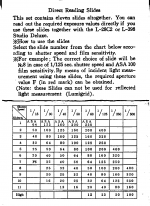There are two "classes" of slides for these meters (Norwood Director, Sekonic L-28, L-28c, L-28c2, L-398, ...):
The first "class" is a set of one slide, the H or "High" slide. With no slide in the meter you use the calculator dial to convert the meter needle indication into ISO-f/stop-shutter speed values or into EV values using the L pointer on the calculator. With the H slide in you do the same using the H pointer. This is the primary way to use the meter for still photography.
The second "class" of slides are the set of "direct reading" slides. When using these you ignore the calculator dial. You choose the appropriate slide based on ISO and shutter speed (framing rate and shutter angle if using cine cameras), using the table if necessary. With the proper slide in place the meter needle indicates the f/stop to use. This is the primary way to use the meter for cine work.


